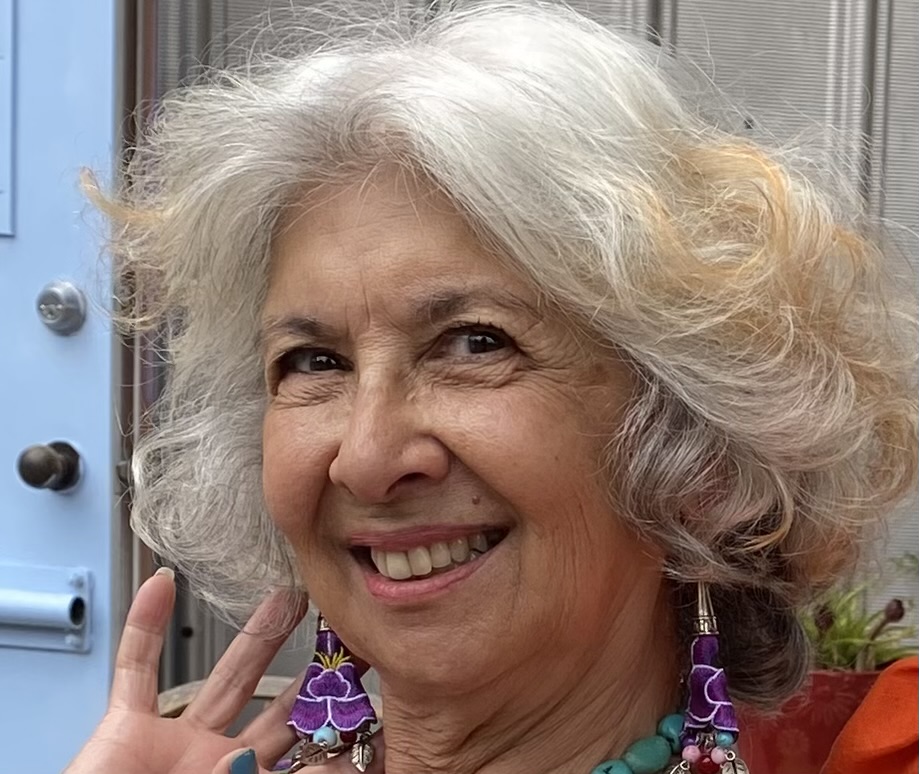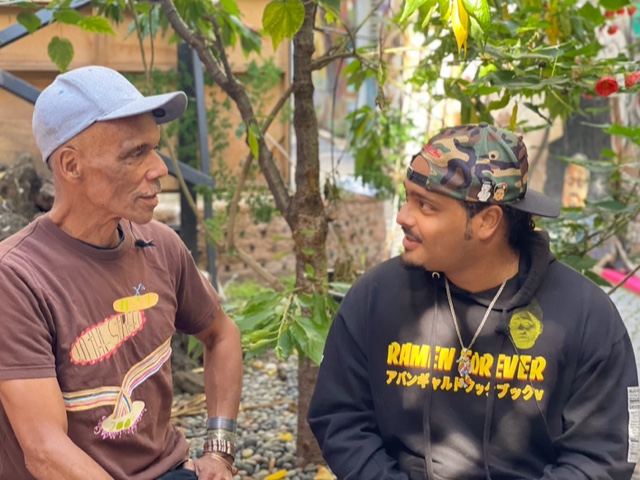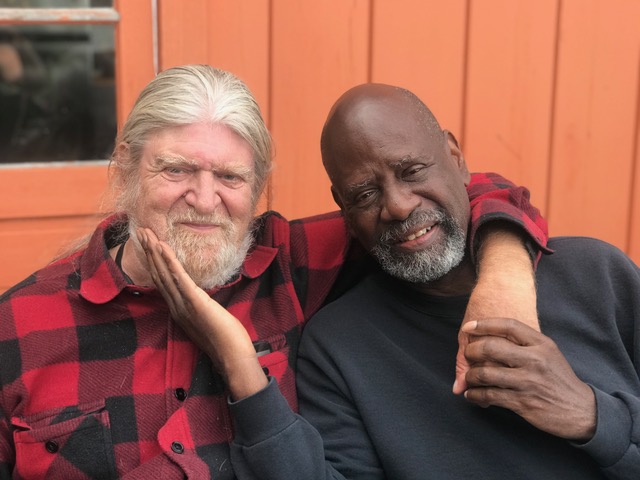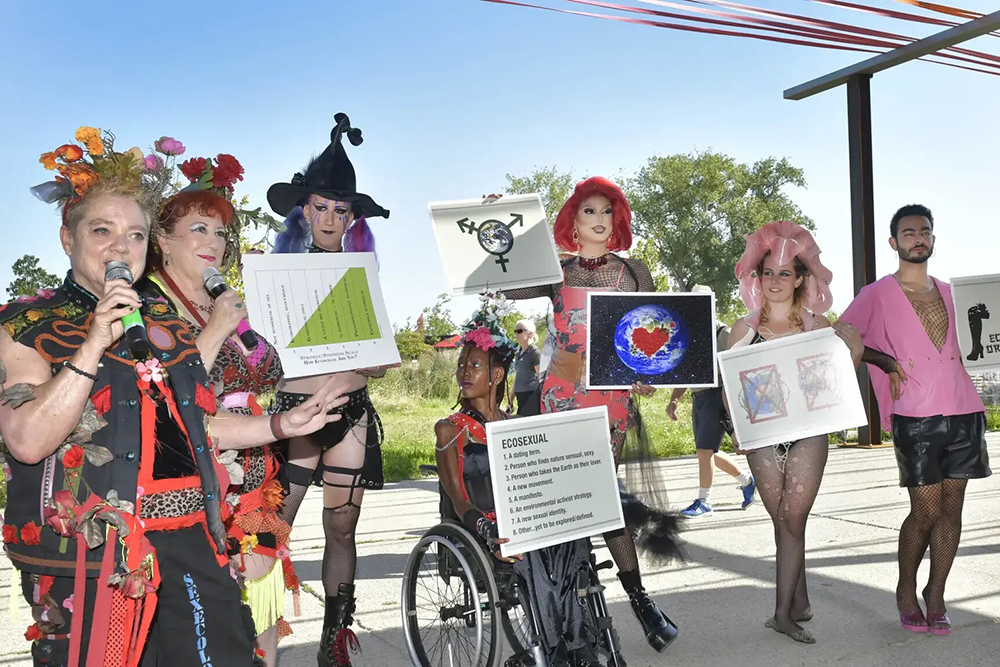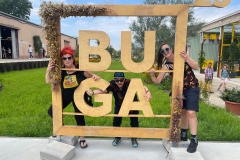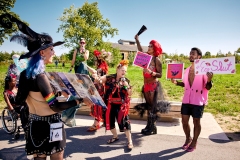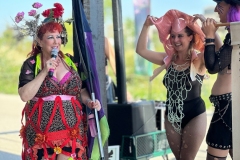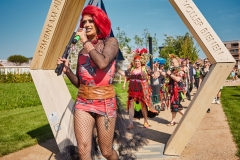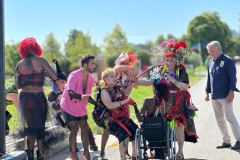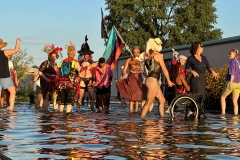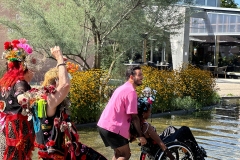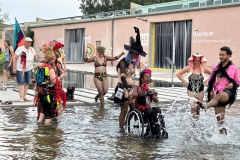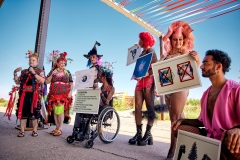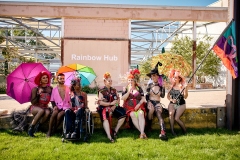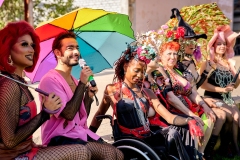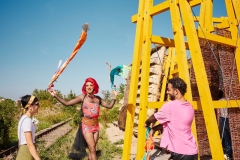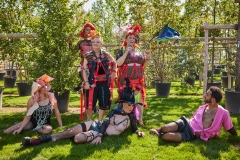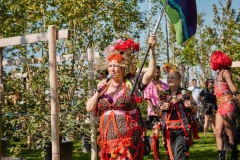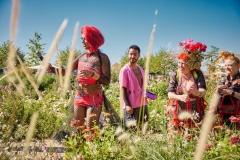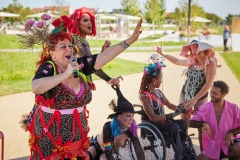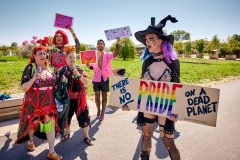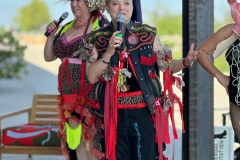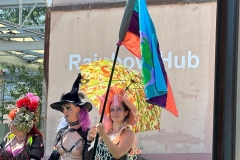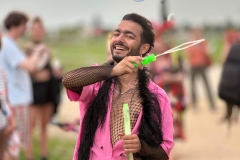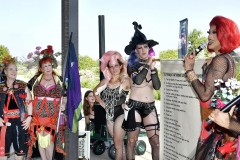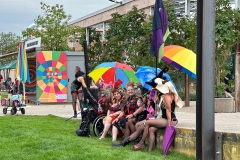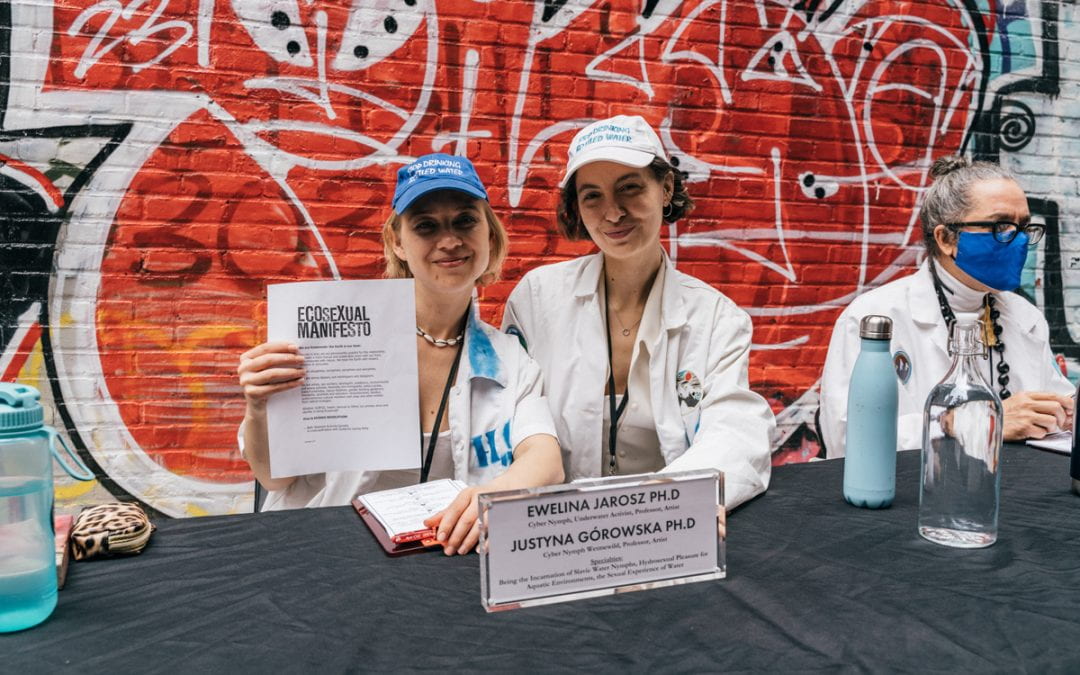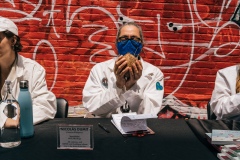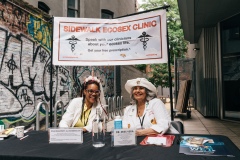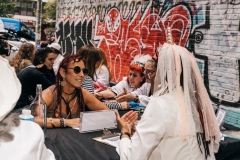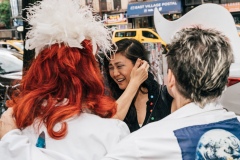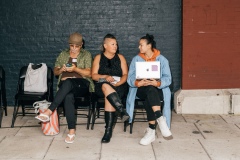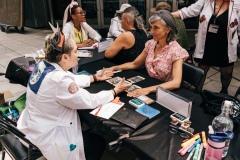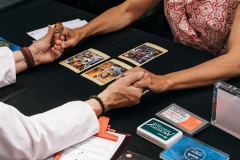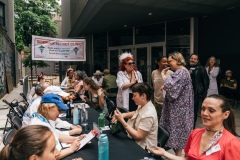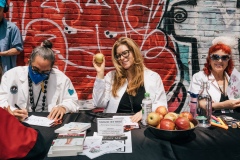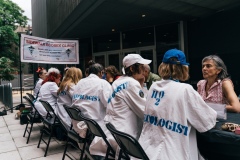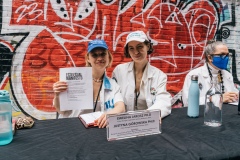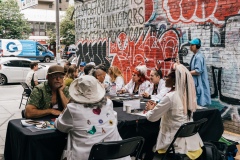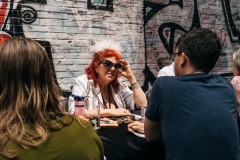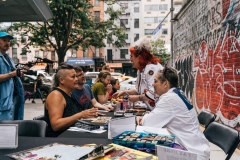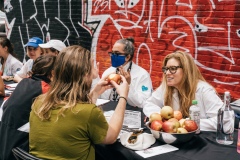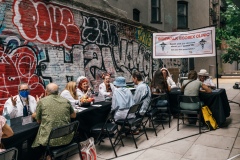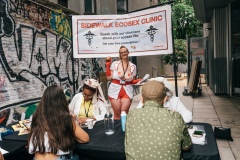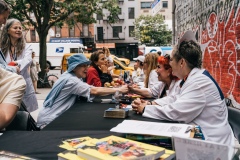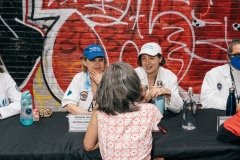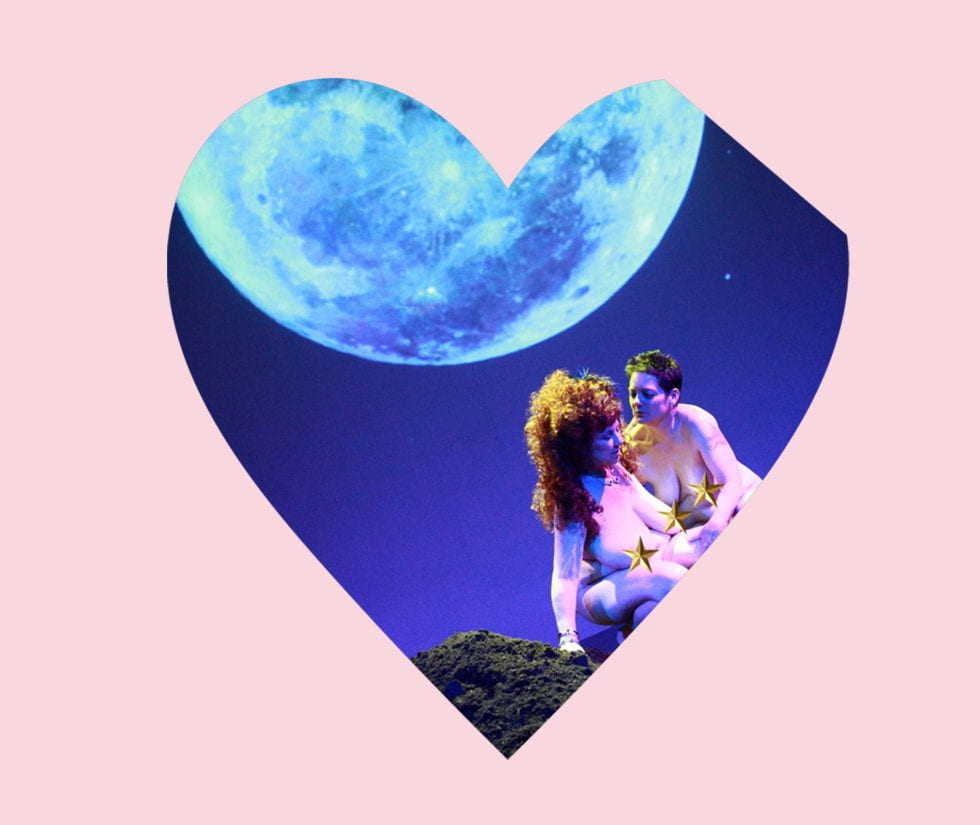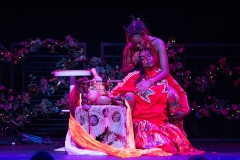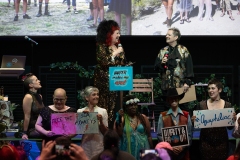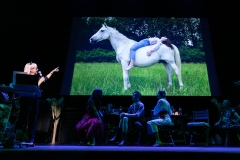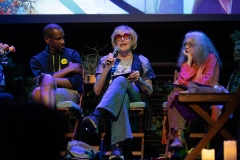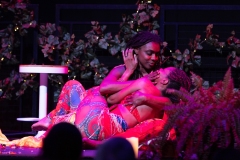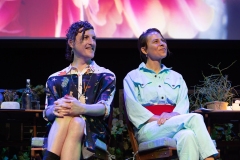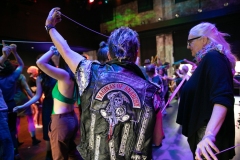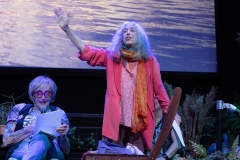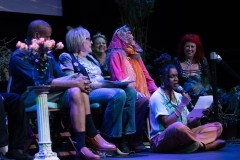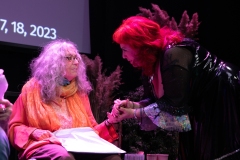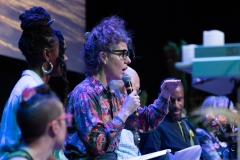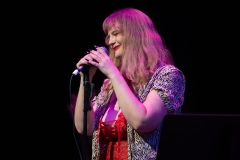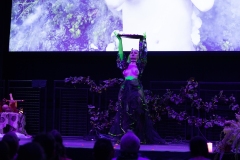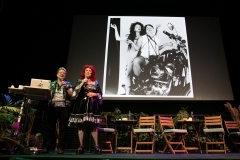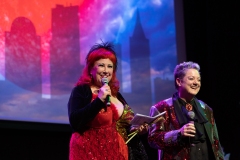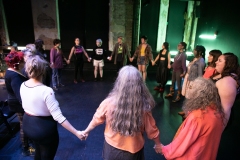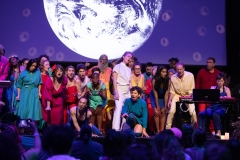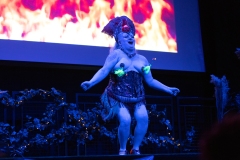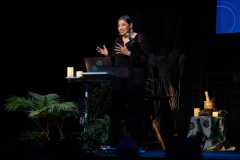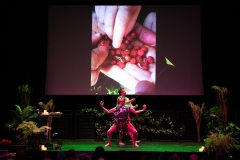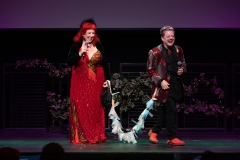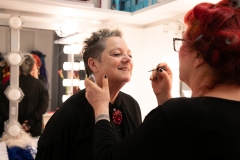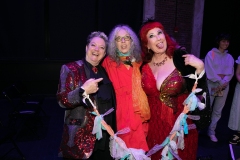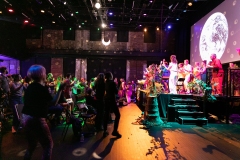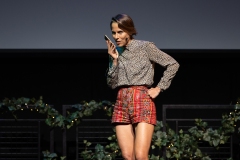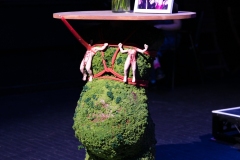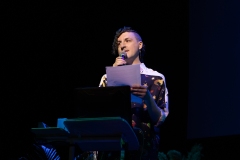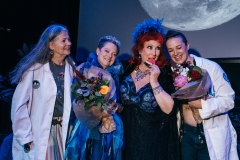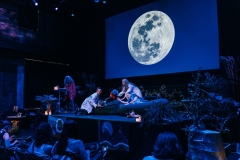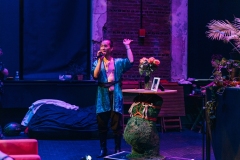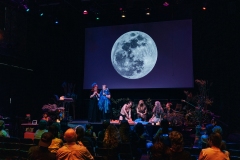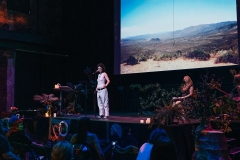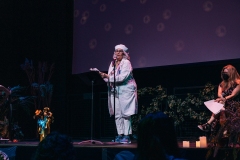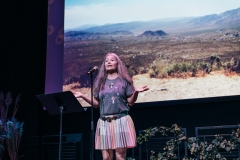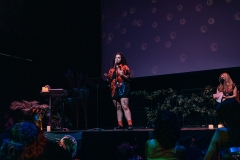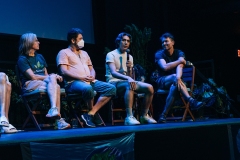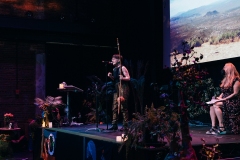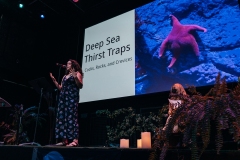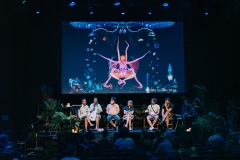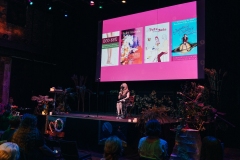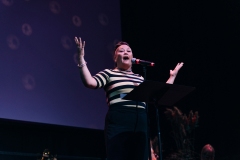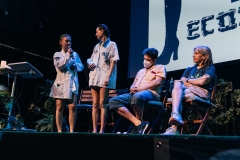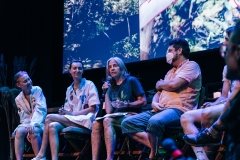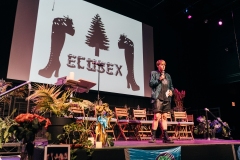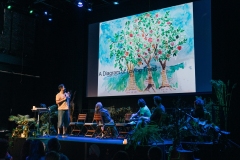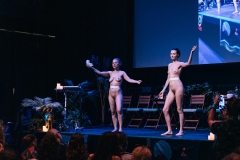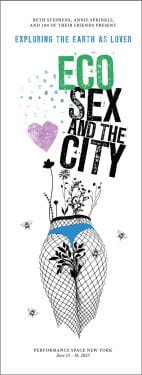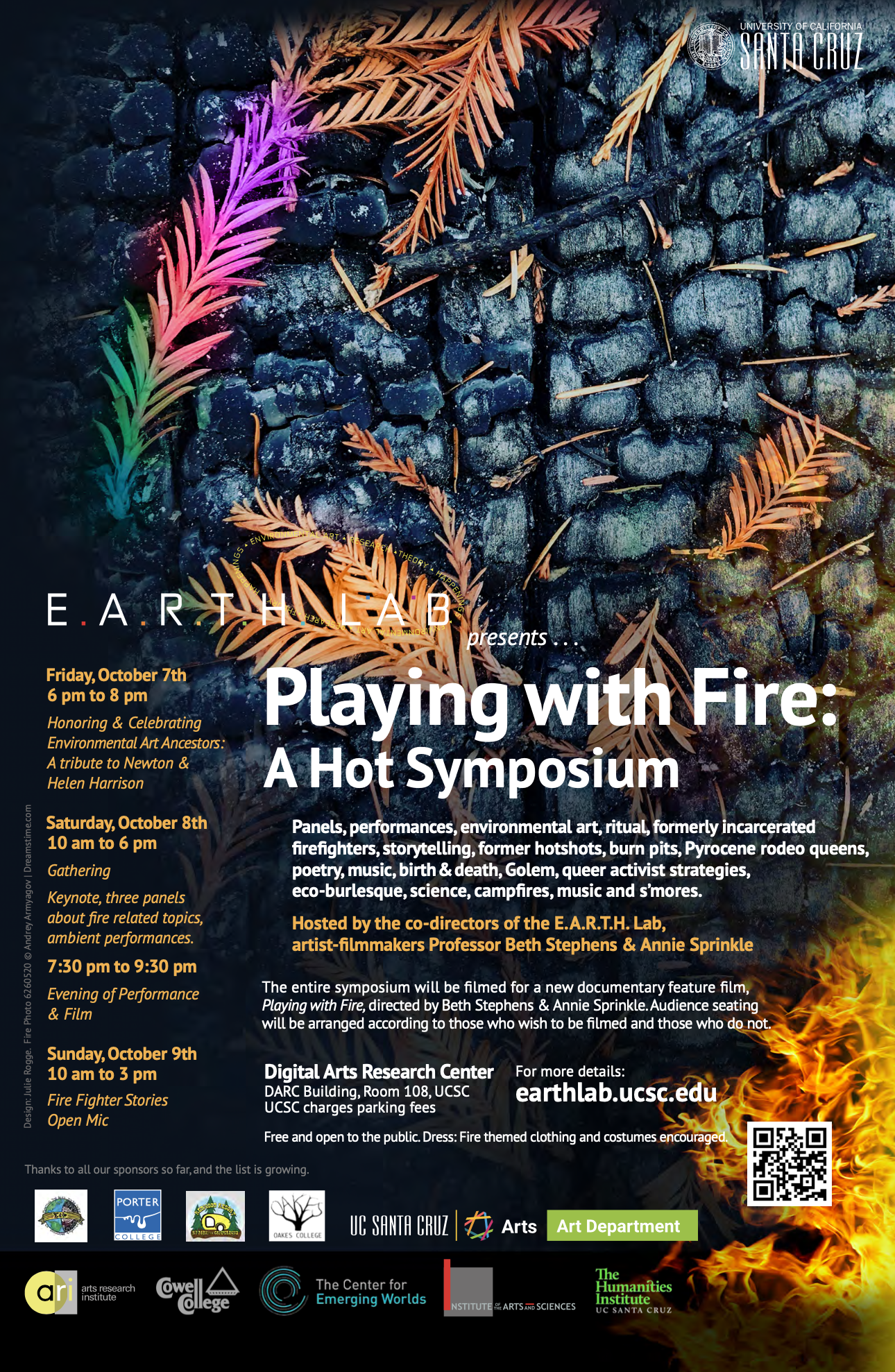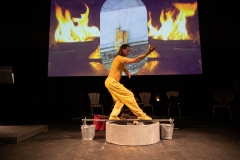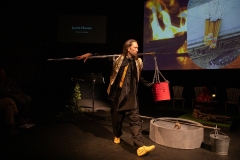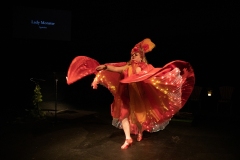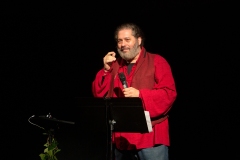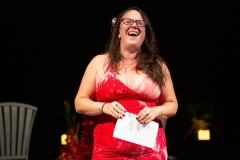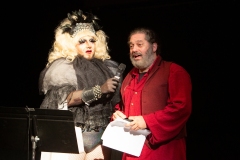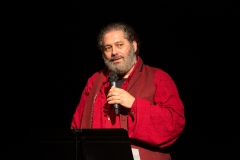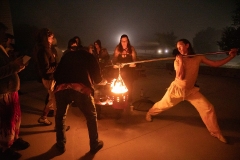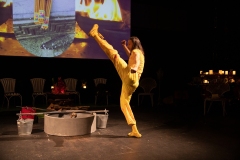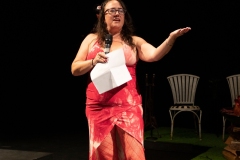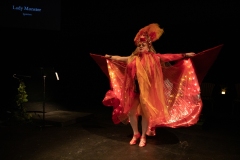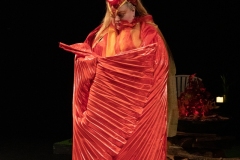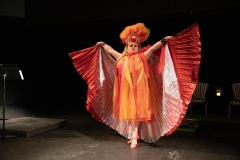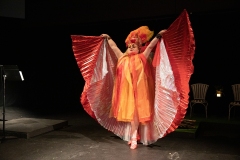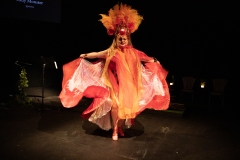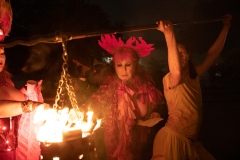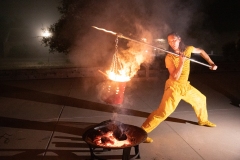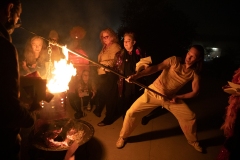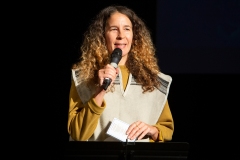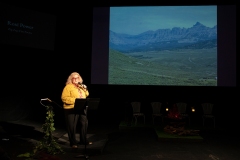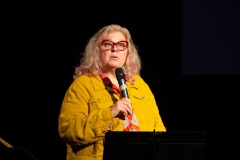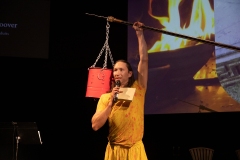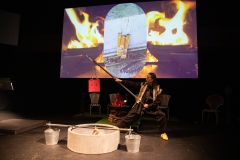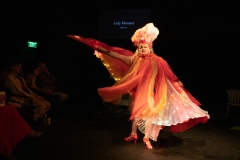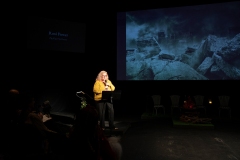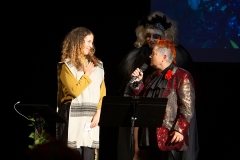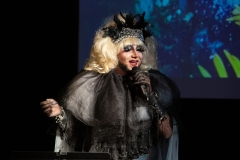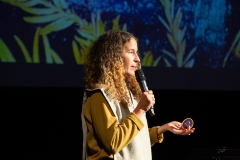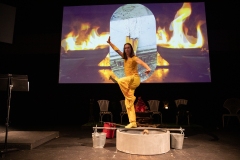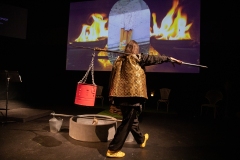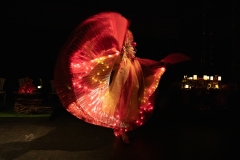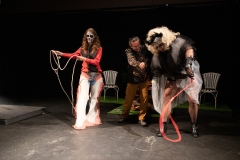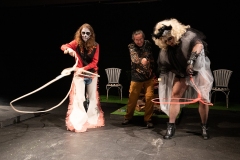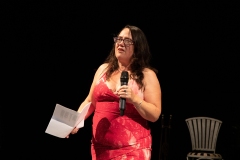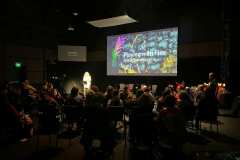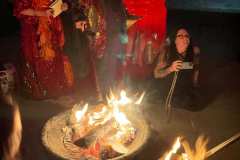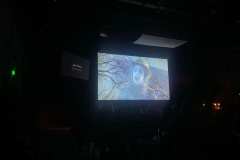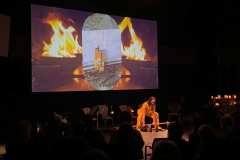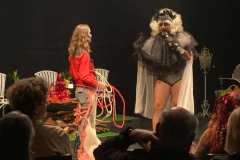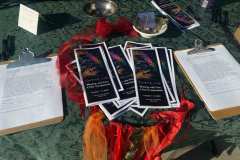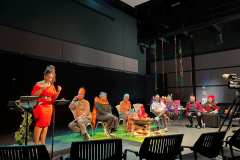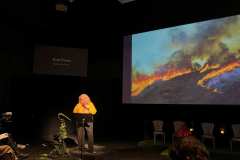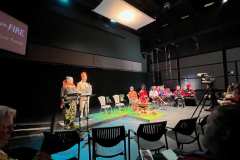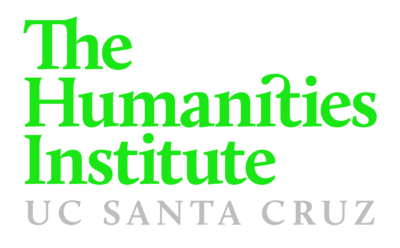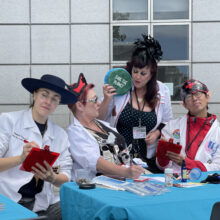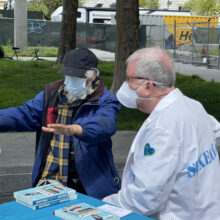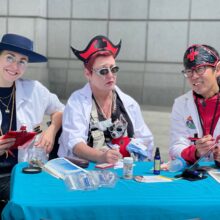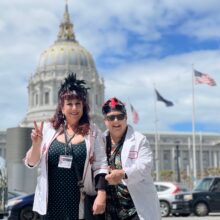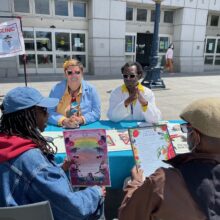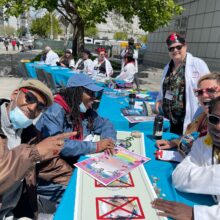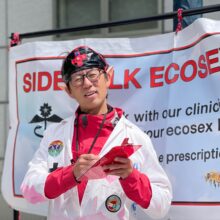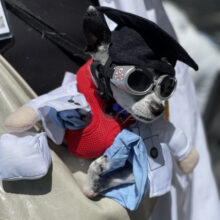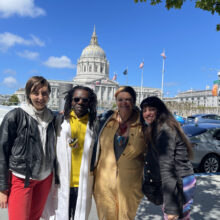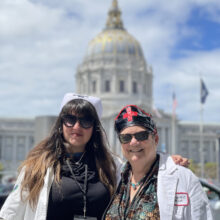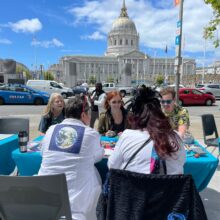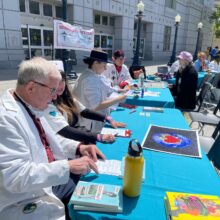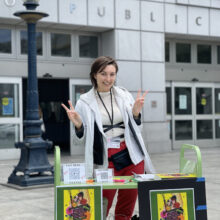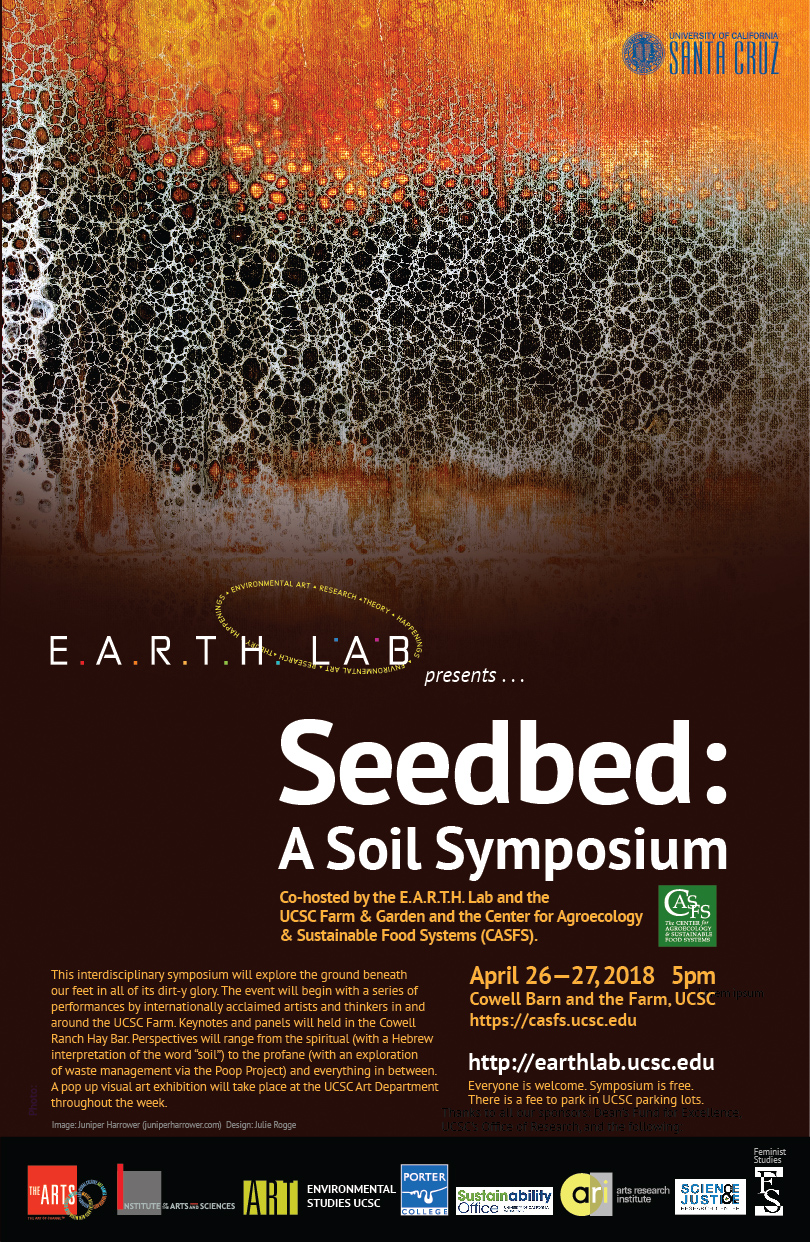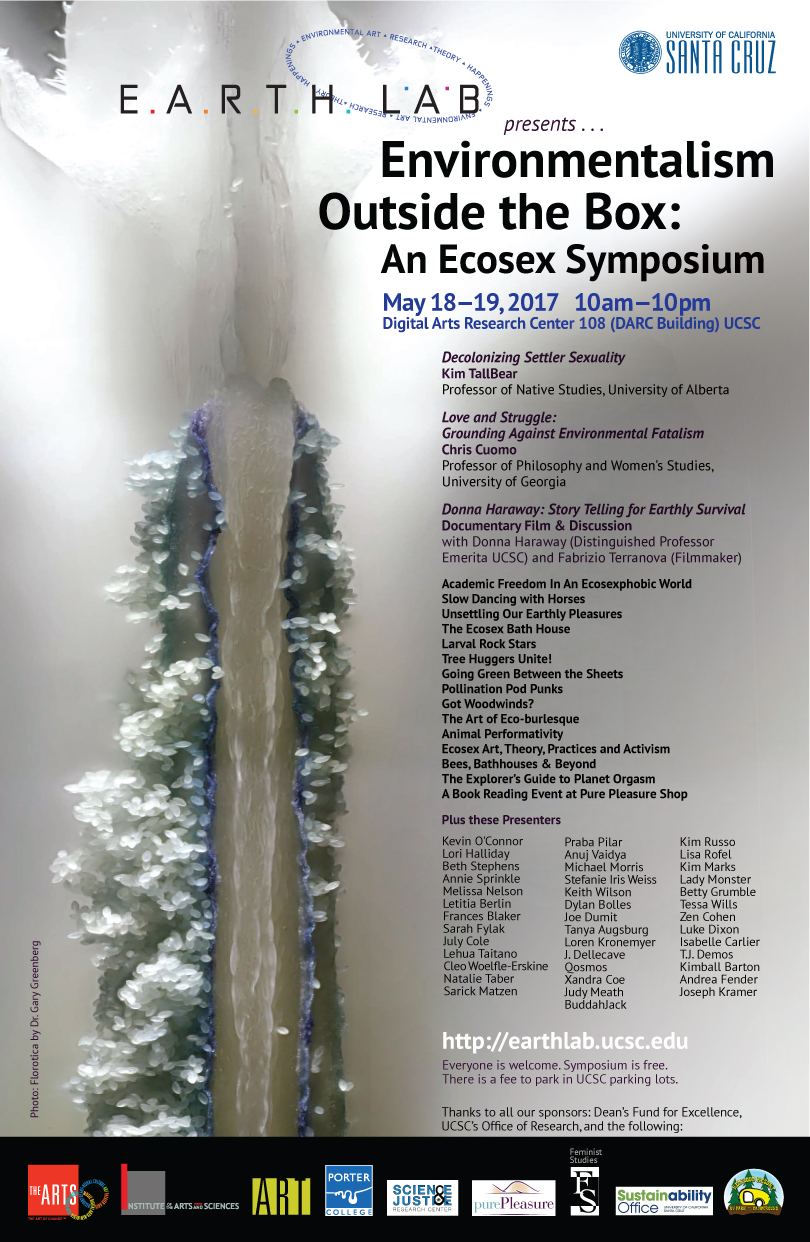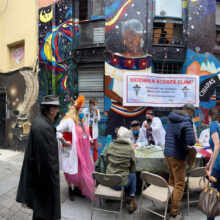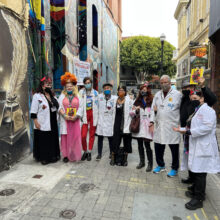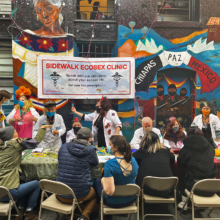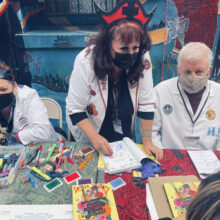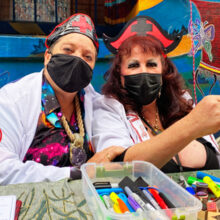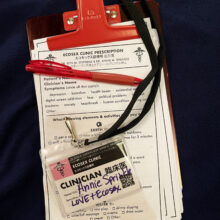Pamela Peniston
Pamela Peniston has designed sets for approximately 20 different Bay Area theater groups and solo performing artists over the past 30 years.
She was a member of the Committee that designed the Cultural Equity Grants Program. Peniston was one of the original co-founders of the Queer Cultural Center (QCC) in 1993 and served as the organization’s Artistic Director for 20+ years. During that time she curated and produced over 20 month-long National Queer Arts Festivals and almost 500 individual arts programs.
Pamela Peniston
Pam Peniston: Let's do it!
AB: I know labels are problematic, but how would you describe yourself? Like artist, queer, politician, producer…
PP: When I told my mother that I had a crush on my teacher when I was young, she said “… everybody crushes on their teacher, it's not a big deal.” She normalized the experience, which in a way discounted it. But it didn't stop. I was in the closet for a long time not realizing I was in there. I finally was brought out or came out in 1983 in Atlanta and I moved to San Francisco in 1984 as an out queer. When I was hired at a law firm for my day job I didn't say anything about that to anyone. But when I told my life story to one of the firm’s lesbian attorneys, she cracked up and christened me the oldest living baby dyke in America. In Atlanta, I had no notion of what lesbian culture was, so SF was kind of a crash course. I was always politically motivated because my parents were that way. And I was an activist, but I was an activist for Black people, and not necessarily for queers.
Now I think of myself as a lesbian queer activist because I still want to keep the lesbian word. I remember describing myself early on to a friend as a gay woman; she said to me “You gotta learn to say the word lesbian.” And I did! It’s like how Jeff is talking about the way that identities have branched out into ‘bigness’ and that we've lost some shape of them. I think that there are young queers coming up who want to identify as lesbians, not rather than queer, but as lesbians first. I like that.
B&A: : Would you put POC or Black in there? Is that not relevant at this point? That wasn't a label that you chose to use.
PP: Oh yeah, absolutely. I think I’m a black lesbian queer activist. You know, for a long time I was mistaken for white but I didn't know I was passing. Then someone would say something racist and I’d freak out. It’s one of the reasons I cut my hair into an afro then grew dreads-I don’t want anyone to mistake me.
JJ: Could you tell us about your life before you moved to San Francisco?
PP: After graduating from Northwestern with my M.F.A., I worked as a scene painter and a set designer in Chicago and New York, and that was keeping me busy. I was doing the graphics for the ABC Affiliate’s weather guy, and eventually I. and the core of our weather office staff, went with him when he moved to Atlanta to start The Weather Channel. At the same time, I was also the graphic artist for Atlanta affiliate WSB’s weather report. I was artistic director for The Weather Channel hiring & managing 12 artists to work the 24/7 shifts. I got my day job in San Francisco in 1985.
Since then, I have designed and painted sets for more than 25 Bay Area performing arts companies: the Magic, Theatre Rhino, Brava, American Conservatory Theater (ACT), Purple Moon Dance Project, Anne Bluethenthal & Dancers and Stanford University. I went back to NYC to design EDEN for NY City’s Negro Ensemble Company (NEC) which was nominated for an OBIE award. Back in SF, I received Critic’s Circle Awards for my set designs of POPPIES and COCONUT at Theatre Rhinoceros. I have worked extensively (& still work) with Rhodessa Jones’ Medea Project: Theater for Incarcerated Women, as a writer, workshop/trainer and set designer.
In 1991 Supervisor Roberta Achtenberg appointed me to the 59-member San Francisco Cultural Affairs Task Force. I served for two years because I was named to the implementation committee that developed the guidelines for the SF Art Commission’s Cultural Equity Grants Program.
After the Task Force I was a co-founder—with Jeff Jones, Lenore Chinn & Rudy Lemcke—of the Queer Cultural Center and I served initially as its Board Chair, then Executive Director. Subsequently I became the Artistic Director and, in that capacity, also the Executive Producer of the National Queer Arts Festival where for 20+ years, I curated, produced or co-produced way over 300 individual arts events.
JJ: Before the Task Force started, six of us formed the Arts Democratic Club. All of the politicians were Democrats, and we felt that actively engaging in City politics was the only way to change the status quo of City arts funding.
PP: Yes. I remember, after the Jeff Jones report none of the largest organizations, and certainly not the Director of Grants For The Arts, Kary Schulman, would say anything other than, “oh, the Jeff Jones report. Feh!” There was almost an implied spit at the end of every one of those comments.
JJ: I remember that individuals kept telling me my statistics were inaccurate. I publicly asked Grants For the Arts to let me know where my numbers were wrong so I could change them. I was never informed. After terrible PR in the press, GFTA decided to organize Festival 2000 to demonstrate it was not racist.
PP: But then Kary Schulman hired someone not from here to direct it. Unfortunately, Festival 2000 went bankrupt after 4 days, and Alma Robinson, the Director of California Lawyers for the Arts filed a class action suit against the City on behalf of all the artists that got ripped off by Festival 2000, which actually took place in 1990.
JJ: At a Board of Supervisors hearing about Festival 2000, called by Supervisor Terence Hallinan, numerous artists testified for almost three hours about the financial problems caused by the Festival. I was the last person to testify and I called for the establishment of a Task Force to guarantee this kind of problem did happen again. And so the City set up the Task Force and that’s where I met you.
PP: Well, let me go back and put a couple of things in here. I’ll share my first memory around Festival 2000. At the time, I was working as the set designer for Cultural Odyssey’s piece entitled Perfect Courage along with Rhodessa Jones, Bill T. Jones, Idris Ackamoor, Brian Freeman and Stephanie Johnson. The Festival opened with that piece; it was an amazing work, but the thing I remember about opening night was the Festival Director hawking Festival 2000 coffee mugs, yelling “buy one of these and save the festival.” Well, he didn't put it like that, but that's what was happening.
JJ: That message signaled the Festival’s coming catastrophe. I didn't know you worked on that piece.
PP: I had worked with Brian Freeman at Rhino and the Negro Ensemble Company before. But Stephanie Johnson pulled me into Perfect Courage; and then I worked with Rhodessa on every Medea Project production after that. But because Perfect Courage was the Festival’s first show, we actually got paid. We sold out a big auditorium at San Francisco State and it was a great show, really wonderful. But within a week other groups, like Urban Bush Women from New York were out here and had no way to get back. Plus they didn't see a dime of their own performance money.
JJ: We were talking yesterday with Lenore Chinn about how Flo Wong and Bernice Bing organized the first exhibition of Chinese American painters at Festival 2000. She was one of those people who got stiffed. I just wanted to ask you about Brian Freeman too, because here we have this prelude of what's coming.
PP: Because he’s on the Task Force, right? Brian's on the Task Force, you're on the Task Force, I'm on the task force. And for a minute and a half, Alleluia Panis was there too.
JJ: Yes, she was. This was the first moment where I kept seeing how all of us were interconnected.
PP: For me, definitely. I met Brian Freeman when I designed Eden for the Negro Ensemble Company in New York. Later, he was temping at my day job at Howard Rice. He came up to me and said, you know, Peniston’s kind of an interesting name, but the only Peniston I've ever known is one who designed for Negro Ensemble Company when I was working there as a technician, and I went, “Brian?!?”
You know, we had a hoot! And he said, “I'm currently working at Theater Rhinoceros and the set designer who was supposed to do this show called Poppies just left. Could you come in? You don't have to show anything.” And I went into Theater Rhino and that began several years of working with Adele Prandini & the crew. So that's how I hooked in, via Brian, with Rhino. So when you asked Adele about becoming a member of the Task Force, she had just moved to Pacifica and was no longer eligible not living in SF, so she recommended me.
JJ: I didn't know that either.
PP: So you called me up and said, “okay, this is Jeff Jones, and here’s how we proceed. You need to be appointed by either Carol Migden or Roberta Achtenberg.” And Brian had already asked Carol. So I contacted Roberta Achtenberg, she interviewed me and we hit it off and I was her appointee.
JJ: So that all makes sense! When I proposed this Task Force I thought about 11 people would be the right size, but suddenly the number ballooned to 59. The Chronicle wrote an article labeling us the San Francisco 59ers. The big organizations thought that they had enough votes to control what was going to happen, but at the first meeting the very first vote was to determine the chair. Alma Robinson proposed that we should have rotating chairs and the large budget groups ran some Union guy from the War Memorial who lost by 2 votes, At that moment it was clear to me that we had a very slight majority. But for about 8 or 9 months these people jacked us all around and then the big moment arrived when Pam…. Well, why don’t you tell this part of the story?
PP: The memo, yeah. So I came in to the Veterans Building for the next Task Force meeting. It was noon, because that's when I got off work on my split shift day job at Howard Rice. I went up to the meeting room: it was empty, but I saw a set of minutes so I grabbed them thinking they were about our next meeting and I walked out of there to go get a sandwich. I didn't look at them until we met at Marie Acosta’s house that evening after yet another contentious Task Force meeting. When I opened up the papers I had picked up at noon I’m sure my eyes got huge. So I handed them to Joan Holden, who handed them to Marie.
What I had picked up were the minutes of a previous meeting at which the major arts organizations had hired a lobbyist to come up with ways that they could maintain the status quo of City funding. They were paying a lobbyist to work against us. We made copies of this memo and we alerted all the major newspapers, queer and otherwise, about the upcoming Task Force meeting where I witnessed some of the finest acting I've ever seen by Marie Acosta. One of the greatest joys of my life was seeing Peter Pastereich, the representative of the Symphony, look at the memo and saying “They have it!”
Marie started talking about how she felt betrayed: “…how could they do this to us when we thought we were coming into this on equal footing with honest intentions?” Which we all knew was not the case. Oh my god, it was a fabulous performance. And that was when they kind of went, oh no. Because the Chronicle and the Examiner started writing about what the majors were doing to screw with all of the little groups that only got 3% of the City’s funds or whatever ridiculous number it was.
JJ: And here again is another Brian Freeman moment. I was standing there talking with Peter Pastereich and Supervisor Hallinan and listening to us was an Asian guy I knew was one of Brian Freeman's boyfriends at the time. Supervisor Hallinan was talking about scheduling a hearing about the Symphony’s violations of its non-profit status, telling Peter Pastereich that the Symphony could lose all their individual donations and all their grants for this kind of violation. Terence Hallinan also pointed out the Symphony and the other large budget groups had also violated a City Ordinance by failing to notify the City that they had hired a lobbyist. Then I introduced Terence and Peter Pastereich to Brian's boyfriend, who I knew was a Chronicle reporter who had just heard everything.
PP: Oh, that's it. Yeah.
JJ: And that's when everything broke down. I just remember that the meeting started, Marie began her interventionist performance piece and people were screaming.
PP: I wish I had a video of that day because I have it so clear in my mind. This orchestrated and truly pissed off a group of artists from the majors saying “we didn't do that!”
JJ: But anyway, after Marie finished her soliloquy and walked out, the entire meeting disintegrated and suddenly Brian Freeman and Miriam Abrams and I went to the Ballet where we met with Peter Pastereich and the Chair of the Ballet’s Board of Directors. Peter said, “what the fuck do you people want anyway?” And I said, “2 million dollars every year for the rest of eternity, for people of color and queers.” They didn't care, they just needed to get out of their serious legal problem.
PP:. But of course it was up to us to show how these funds could be created. They said, you come up with a way that our budgets don't get cut. They didn't want to go back to their boards and say, “Oh, by the way, we're losing 5% of our revenue from these grants as well as possibly losing our non-profit status.” They had a political problem as we’ll as a funding issue. That's when you, me and Marie sat down and started trying to come up with plans and proposals. And I remember we went to the Phone Booth, which had to have been one of the oldest gay bars in the City.
JJ: Yes, on South Van Ness and 25th Street.
PP: We sat there and figured out that since its inception The Hotel Tax had increased its revenues by an average of x percent per year and that if the City used only the annual increase to fund BIPOC, Queer and women’s organizations for three years, we could create what eventually became the Cultural Equity Grants Program.
JJ: Anyway, we still got the 2 million dollars, which was more than the City spent at that time on BIPOC and LGBTQ arts communities. The 2 million dollars was totally earmarked. Theoretically, you're not supposed to be able to use race as a determinant factor.
PP: Right, no.
JJ: We did it anyway and nobody has ever challenged that.
PP: Annie, you have a question?
AB: What was the core impetus that drove the two of you to give up so much time and energy and to fight for this? What drove you so hard?
PP: I think it was our communities. We were getting screwed. I mean, speaking as a black lesbian and with the grant writer for almost every other organization of color in San Francisco, we saw how nobody was able to get beyond a certain point. We were being held down, incredibly hard. Even if you had an Executive Director making $20,000, you couldn’t pay anyone else. We needed more groups to access Grants for the Arts (GFTA), which Jeff took as his personal challenge. And we also needed organizations to secure enough funding to acquire an adequate administrative staff infrastructure.
I was lucky because I happened to be working at a law firm as a receptionist and so I went to the legal assistance division and asked how QCC could file for non-profit status. They told me everything I had to do and how to do it. We got our first set of bylaws by editing Theater Rhinoceros’ existing by-laws, although we had to had to add several items: our by-laws said that QCC had to be governed by a majority of people of color. That was put in there so people knew that we were talking the talk and walking the walk.
We watched all of these groups, queer or straight and also BIPOC, not have any access to real money and then die off after a certain number of years, or never get beyond a certain point because they couldn't hire a staff or get their 501c3. So we got ours and we started talking about how cultural centers could become the fiscal sponsors of smaller emerging groups. So setting up a fiscal sponsorship program was one of the first things that QCC did once we were established.
JJ: I would contend that the alliance between people of color and queers was how we emerged victorious from the Task Force. That alliance was too strong for the large organizations to co-opt. After the task force, we ended up with the implementation committee that was going to design the programs, develop the guidelines, etc for the Cultural Equity Grants Program. Once again the alliance was Pam, Marie Acosta and Idris Ackamoor.
PP: And you, who could only be an observer and attended every meeting; they wouldn't let you actually be on the committee.
JJ: That's right. I was considered “a special interest group.” On the other hand, Kary Schulman (The Director of Grants for the Arts), was on the committee and so was the Director of the Arts Commission, an agency with little power and no credibility. When Schulman said that her agency should distribute the money since she was already distributing the City’s arts grants, that became an over my dead body issue. After all, the Cultural Equity Grants Program was established to correct Schulman’s failure to address the needs of the BIPOC and LGBTQ communities, so the management of the program was assigned to the SF Arts Commission.
PP: The Head of the Arts Commission at the time had zero understanding of the current San Francisco artistic scene.
JJ: Yes, but the real next step was to allocate the funds so we had to come up with the programs and the guidelines. To make sure that the Arts Commission and/or Grants For the Arts could not subvert the Task Force’s intent, Supervisor Hallinan made sure the Board of Supervisors and the Mayor established the Cultural Equity Endowment’s programs and rules as an ordinance, which had to be repealed or amended by the voters or the Board of Supervisors to be changed.
The people in City Hall were so sick of the arts community: we were consuming a significant percentage of their time, even though the funds in question were at most one-tenth of 1% of the city's budget. Although common wisdom held that the arts community was very liberal and progressive, in fact the arts community was just about the worst. There were so many people with blatantly racist views who got away with them because they were in the arts.
But I have another question for you: what do you think this alliance really meant in terms of moving the arts world forward?
PP: For one thing, it set a precedent. It was picked up by so many other Arts Councils by osmosis: they knew what had happened here and they didn't want, as public employees, to get embroiled in a divisive race-related discussion that could ruin their reputation and future careers in the arts. Also, QCC's initial board was such a diverse group by discipline, ethnicity, race, politics, everything. We were all over the place and we knew almost every member of the Board of Supervisors. I had designed sets for many straight theater companies, Lenore Chinn had served on the Human Rights Commission, Greg Day was totally engaged in expanding services to Queer teenagers and youth living on the streets. Rudy Lemcke was well-known in the visual arts community. We each had individual networks we could bring to bear on this.
I think one of the ways we succeeded was to convince the members of the LGBTQ and BIPOC communities that we all win as long as we stand united. We said “Stop thinking of each other as competitors and start thinking of a what a level playing field would mean for all of us. Start thinking about how your organization can get funding from both the Arts Commission and Grants from the Arts.
I also think that the Alliance was unbreakable because those ignorant public statements made at the beginning of the task force were no longer politically acceptable in 1997 or 98.
I think you'd be fired if you told the Board of Supervisors that “Black people don't like modern art.” They just can’t make these blatant racist comments in public anymore.
JJ: Immediately after the victory around cultural equity, the Boards and staff of the 4 neighborhood cultural centers convinced the SF Arts Democratic Club to join them to improve the disastrous situations then prevailing at the 4 City-owned neighborhood cultural centers.
PP: This new Alliance’s goals were to stabilize the 4 existing cultural centers and to create 3 “virtual cultural centers” serving the Asian /Pacific Islander, Native American and the LGBTQ communities. Central players in this effort were Jack Davis, the Director of SomArts and Maria X. Martinez, the Chair of the Mission Cultural Center, who became the President of the San Francisco Arts Democratic Club in the mid-1990s. Both of them had access to Willie Brown, who became the Mayor in January 1995. Two years later Mayor Brown and Supervisor Bierman successfully increased the City’s annual allocation to the cultural centers from $600,000 in 1996 to $2,200,000 in 1998.
The next important move forward occurred when QCC and La Galeria de la Raza developed a technical assistance program that subverted the status quo by training BIPOC and LGBTQ artists and administrators of color to improve their grant-writing skills. Carolina Ponce de Leon, who became the Director of Galeria in 2002. QCC’s Development Director Jeff Jones and Marie Acosta conducted workshops that taught the participants to how to understand the funders’ guidelines, how to speak the language used by the funders and how to make proposals more compelling to read.
That was a really important step for us, because suddenly, instead of having one annoying queer group writing a million grants, we had 20 annoying queer groups that were writing really good grants because they were understanding how the grant world worked. Could work. They had to write their first drafts for QCC and our application’s format was based on the SFAC Cultural Equities Grant. Once QCC’s fiscally sponsored clients understood how to read the questions, they could be taught how to answer them.
Both Galeria and QCC held mock peer-review panels as part of the grant writing training program. Although we told participants they did not have to stay for everyone else’s feedback sessions, almost all of them stayed because they wanted to hear how the panel reacted to everyone else's proposals and to identify “what they were missing.” Through our Creating Queer Community program, QCC subsidized the growth of Radar Productions, Fresh Meat, the Queer Women of Color Media Arts Project, Femina Potens, the Dyke March, the Trans March, Army of Lovers, the Queer Ancestors Project, Still Here Productions, the SF Transgender Film Festival, Queer Rebels and so many other Queer arts groups as well as LGBTQ individual artists.
JJ: It was really the Cultural Equity Grants program that built up all of those organizations. And even today The Cultural Equity Grants program has supported Annie and Beth’s organization—EarthLabSF. Groups that can only get $10,000 from Grants for the Arts, can get a $50,000 a year grant from the Cultural Equity Initiatives Program.
JJ: Radar was the first to get funded by Grants for the Arts.
AB: Michelle Tea was the founding Director and did that series of fantastic Radar Reading events at the San Francisco Public Library. We got to go on a Radar writing retreat to Akumal, Mexico. It was phenomenal and what we wrote, we later used in our book, Assuming the Ecosexual Position.
Annie Sprinkle: Also, you produced my one woman show, Annie Sprinkle’s Herstory of Porn as part of the QCC Festival at Theatre Rhinoceros. You made me a great theater set. I had been traveling the world with my performance art theater pieces in the 90s, and I don't know that I ever had any producers, curators or set designers of color at that point. I remember how I was kind of wowed, like I’m in San Francisco and there's this amazing person of color producing and curating at the QCC. Do you feel like that was rare at that time, or did I just go to the wrong places. Did you have formal training? Do you consider yourself an artist? Is that an important label for you?
PP: Yeah, my MFA from Northwestern is in scenic design: my training and background in scenic design and scene painting. Photography was kind of an ancillary thing. Initially it was what I did to record what I'd done, like taking pictures of sets. I don't remember feeling unique, but I was so busy with QCC. First, we were busy for 4 months before the Festival, then it went to 6, then to 8. And then at a certain point we were busy all year long. But I began to work more in photography and the visual arts because I had 2 incredible visual artists to train me, Lenore Chinn and Rudy Lemke, who helped me identify myself as an artist. It took a long time for me to call myself an artist, outside of being a scenic artist and set designer.
But back in the 1990s, there were groups for whom $5,000 made an enormous difference. All of these groups were doing such amazing work: and look what Sean Dorsey and Fresh Meat are doing now, what EarthLabSF is doing now; Queer Women of Color Media Arts project became an international phenomena; Sean Dorsey just finished up a tour in Europe. For me. it is really exciting to see how the seeds that we planted twenty years ago have continued to grow.
I remember going to Italy on one of my pilgrimages and being invited to the Gender Bender Festival in Bologna. When I congratulated them for their exciting and brilliant program they said, “well, we stole it all from your website, not the artists, but the whole idea of incorporating things in this way.
I think QCC's board really helped provide the vision for the idea that we should always reach out to people in different corners of our community. For me, it's always been about giving voice to the people nobody's heard before. Like queer prisoners, and being able to create a comic book working with the folks in San Quentin. Ultimately it was these different groups branching out and doing their own thing that in some cases got bigger than we did.
JJ: Yeah, that's true. We're gone and they're still around. I have been having these conversations with Marie Acosta and Ellen Gavin recently, and I feel like the Post-COVID arts community is now at a new place. For example, if we go back over history and we look at the word ‘multicultural’, in the 1990s that meant people of color. Suddenly this term was replaced by LGBTQ and People of Color or BIPOC. Originally the rap on multiculturalism was, Black people have one foot in the United States culture and another foot in African culture. And that made sense, but only because we didn't have the vocabulary yet to be able to talk about what we were thinking. And I feel like we’re at that same place once again, where we do not have the vocabulary to talk about groups like Annie and Beth’s, and what they do. ‘LGBT’ or ‘people of color don’t adequately describe their programs.
There's a bunch of groups like EarthLabSF in the arts community that all four of us would be proud to work for and they're not all people of color or Queer. I went to this Oakland Theater Project production of the Mahabharata performed by one solo actor who staged a 90 minute rant dressed as a trans Indian person; to read this epic takes upward of 40 hours. But this organization has black people and Asians and white people and I feel like that's what Marie Acosta is telling me that she keeps running into in the State of California: groups that have lots of vitality and are really on the move but are not culturally specific: we don’t have a word yet that adequately describes what they are. I feel like we're back in that spot where instead of race and gender being the defining things that make great art organizations, it’s something else.
PP: But I think it's still incredibly valid to say that those people’s voices had been pushed away. Like the Oakland Theater Project, for instance,
was started by a bunch of white folks who called themselves Ubuntu. I was talking to Stephanie Johnson, a brilliant lighting designer who I worked with at Rhino and the Medea Project and we both felt it was inappropriate for a bunch of white guys to calling themselves Ubuntu—an African name. Stephanie had a long sit down with them and said “this is why you're never going to be anything but what you are.” They were employing black people and other people of color but it wasn’t until they voted to change their name to Oakland Theater Project and started adding people of color to their board and staff that the company artistically emerged and they could actually begin to produce the work that they wanted to produce.
That's one of the really intense impacts of what QCC actually did, and of folks following us and coming in from different directions. Which is to say, if you want to do a production with a lot of different voices, featuring a particular community, you need to have the input of members of that community. If you're gonna do a James Baldwin piece then maybe a black person should be in it and maybe direct it. Then you won’t leave yourself open to being called an asshole and a racist, and it also means that you can expand the work. If you said, “I don't want to have any women or transgender people on this board and I want to keep them all white.” I’d say “okay, have fun with that, bye.” It's the same thing. And now you hear that, “I want to do this play that was written by a woman but she's not interested unless I have a female director.” These kinds of little things add to the breadth of what’s ultimately produced: it's no longer necessarily culturally specific, but maybe its multi-cultural and multi-racial. And by the way, plenty of culturally-specific groups are still working and still doing something special.
JJ: Yes, there are many of those. But the funding world is confused because it is still stuck where we were in the nineties. To me, the California Arts Council (CAC), which was the leader during the 1980s and 1990s has not progressed much since then. No one on staff or the Board seems to actually evaluate what CAC is spending their money on and many people believe that what they are doing really sucks. The staff believe CAC should fund networks and Local Partners in all parts of the state instead of prioritizing financially supporting the state’s artists and arts organizations who create and stage art for the public.
PP: Yeah, but they've been heading towards that precipice and periodically falling off of it for years. When I spoke at the Grant Makers in the Arts conference in 2018, participants were talking about CAC’s problems. My analysis was that CAC didn’t know what they didn’t know.
JJ: It's even worse now because they've spent millions of dollars with absolutely no artistic vision whatsoever. There are wasting a vast percentage of their money by spending it on administrators and administration instead of financially supporting art organizations who produce new work and/or provide meaningful services to their local arts communities. Hopefully the recently appointed Director of the Agency will change this stagnation; previously, she has solidified her successful career by advocating for the arts in Los Angeles County.
PP: So are they continuing that ridiculous networks program?
JJ: Yes. In 2002 or 3 the California Arts Council's budget went from like $30,000,000 to $1,000,000. They had nothing left. And they had a gay director. They started this bullshit networks program when he was heading out the door because he wasn't going to work for Schwarzenegger. And I said to him, “since you're handing out patronage these days, could you please direct one of your patronage grants towards the queer community?” And he said, “send me a proposal.” I sent the proposal the next day and QCC received $10,000 to run the statewide Queer Artists network. And for the next 15+ years QCC still had this grant. After the early years, the members of the network never met and I only visited Southern California twice. We sent out monthly newsletters and this met the criteria for ongoing funding. Most of the network’s $10,000 grant was funneled into our operating budget.
PP: Yeah, and funneled out again to Queer artists doing some pretty fabulous local work.
JJ: The California Arts Council’s funds have been captured by special interest groups, the so-called State and Regional Networks and the State and Local Partnerships. I haven’t figured out exactly what percentage of CAC’s budget pays for the Networks, the Partners and Staff; but my inner calculator thinks that these administrative costs consume almost half of the funds, instead of the artists the state legislators believe they are financially supporting. Sorry, I feel like there are too many stagnant organizations that have been around for 20 years that should get $0.
AB: I know. I think it's who's on the front lines too Jeff, like trans people of color are really on the front lines.
JJ:. What I am interested in is trying to come up with some way of describing what is happening in today’s statewide arts community and ironically the only word I can come up with at this point is “ multicultural.” I know it's not accurate, but the people who are “othered” in this society are the people who are now creating compelling art, and it's not necessarily specific to being queer or to being a person of color or being a woman or any of that. It's all of these things, together. I feel like this is the next level and where things are headed.
Beth Stephens: Sadly the “others” are being attacked and those are the voices we need to amplify. The state’s universities are dealing with this issue too. Universities are getting roundly attacked by white supremacist Trustees; it’s part of a pattern that includes anti-abortion prohibitions, book banning’s, “Don’t say Gay” Laws, voter suppression regulations and the highest number of introduced anti-LGBTQ laws in the nation’s history. The same questions of “how do we categorize people?” and how do these categorizations overlap? I'm asking myself, “how are we going to take this work into the future? What's the language going to be in order to preserve the Queer artistic legacy that has emerged in San Francisco without it being erased or wiped out”
I'm really appreciating this conversation a lot. We’ve found that with environmental work, if you're just trying to survive and feed yourself and stay alive and make art projects, that environmentalism is kind of privileged. It's a big umbrella, but it isn't always in your face
PP: But I think that environmentalism and environmental justice are one of today’s hot-button issues because all the bullshit seems to get located in communities of color. Like “hey, we're gonna put this toxic substance under your playground but don’t worry it will be sealed up.
AB: “We're gonna put your house on top of a uranium dumpsite but don't worry about that either because we're creating housing for you at Hunter's Point, right?”
PP:. Yeah! Right
JJ: An arts colony on a super-fund clean-up site.!
JJ: Pam, before we end, we have not really discussed your
artistic career as a presenter and a curator. You were the curator and provided the artistic vision of every single National Queer Arts Festival for over 20 years.
PP: I was often on the committee for the visual arts show as well. So I'd say probably between 15 visual arts shows and 300+ performances, readings, screenings and panels.
JJ: I remember you giving a speech somewhere where you talked about how your artistic vision was diversity. And that really was very different. Thank you.
Annie: So Pam, you have done so many things. What do you feel has been your greatest achievement in your lifetime career?
PP: Oh, I think it was giving voice and validation to so many artists who were tenuous about moving forward or who didn't realize that they had something. I started chatting with artists at the end of a show and said “that was really remarkable, and you need to continue to work on this kind of thing because even if it isn’t finished yet, it’s on track to be.” I tried to make sure that I made young artists appreciate how valuable they were to the LGBTQ community. Because representation has been and continues to be such an important thing, so when someone convinced them that their stories and lives were well-represented, it made them aware of their importance that they didn't realize they had. It touches them. So for me, it was about acting with, and reacting with, and working with the young artists coming up. It was about saying “this is vital, not only for your own development, but this is vital for the people who will come after you and for your community.” One of the most rewarding and incredible things was being able to work with emerging artists and getting down and dirty with them and curating together.
Then came the realization of the way that mid-career artists and emerging artists could connect; how the former could help the latter, but also how the latter brought new ideas with them.
Beth: Why art? You worked at a law firm. You saw how the law and politics work. You know the many ways one can make a difference. Why did you choose art?
PP: It chose me. I felt like art was the velvet hammer. When you go into a production, you usually expect to be entertained, but you don't necessarily expect to be informed, and you don't necessarily expect to have your life upended. But that was the kind of work I wanted to do, to bring people to that point.
I remember one of the first QCC programs that Thea Hillman did with Rocco Kayatos was called Class Action Suit. It was a show about class within the community, and they informed me we’d have a Q & A afterwards because the show was only about an hour and they really wanted some feedback. They planted me in the audience with some questions, but I never got to open my mouth because the audience was dying for this kind of a discussion.
Class is frequently a contributing factor that adjoins racial bias. We had to cut off discussion after 40 minutes because we had to vacate the room. But it was that kind of discussion and the kind of art that changes lives. Also, working with Rhodessa and Idris on the Medea Project caused many people to come up to me after the performance by the Incarcerated Women and said “Oh shit, there but for the grace of God; I just didn't get caught.”
Just realizing how art could make you face yourself, and the world, in a way that was authentic and a little bit subversive is why I stayed in the arts community for so long.


